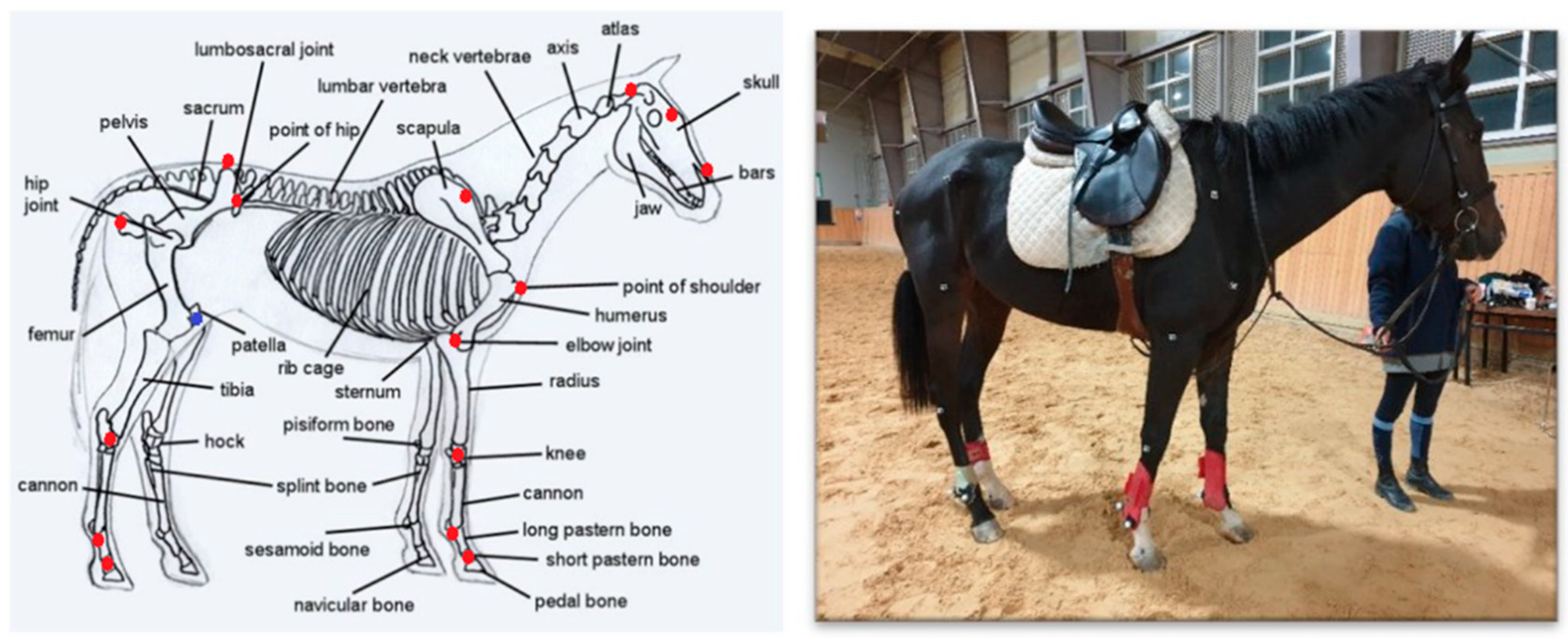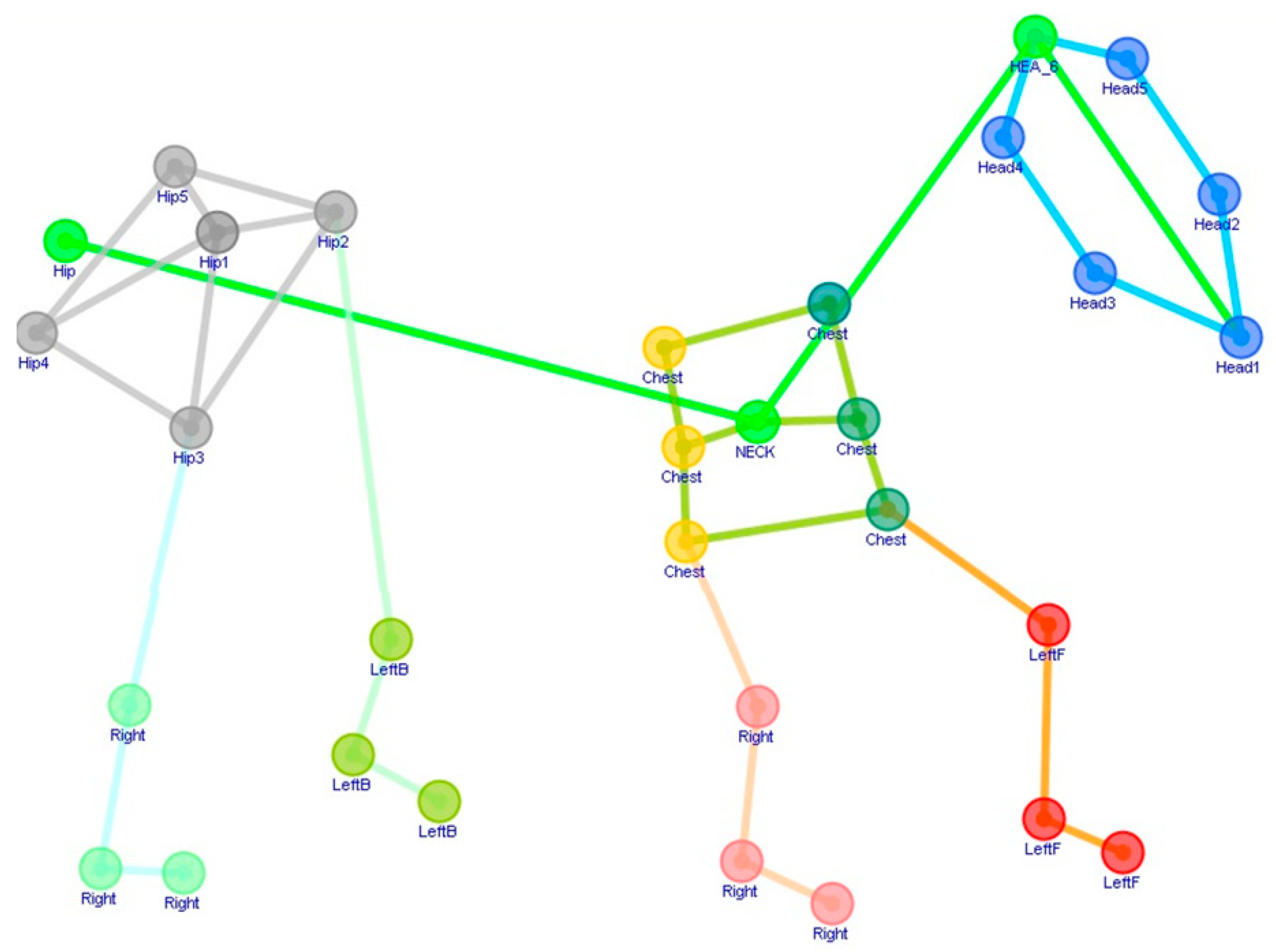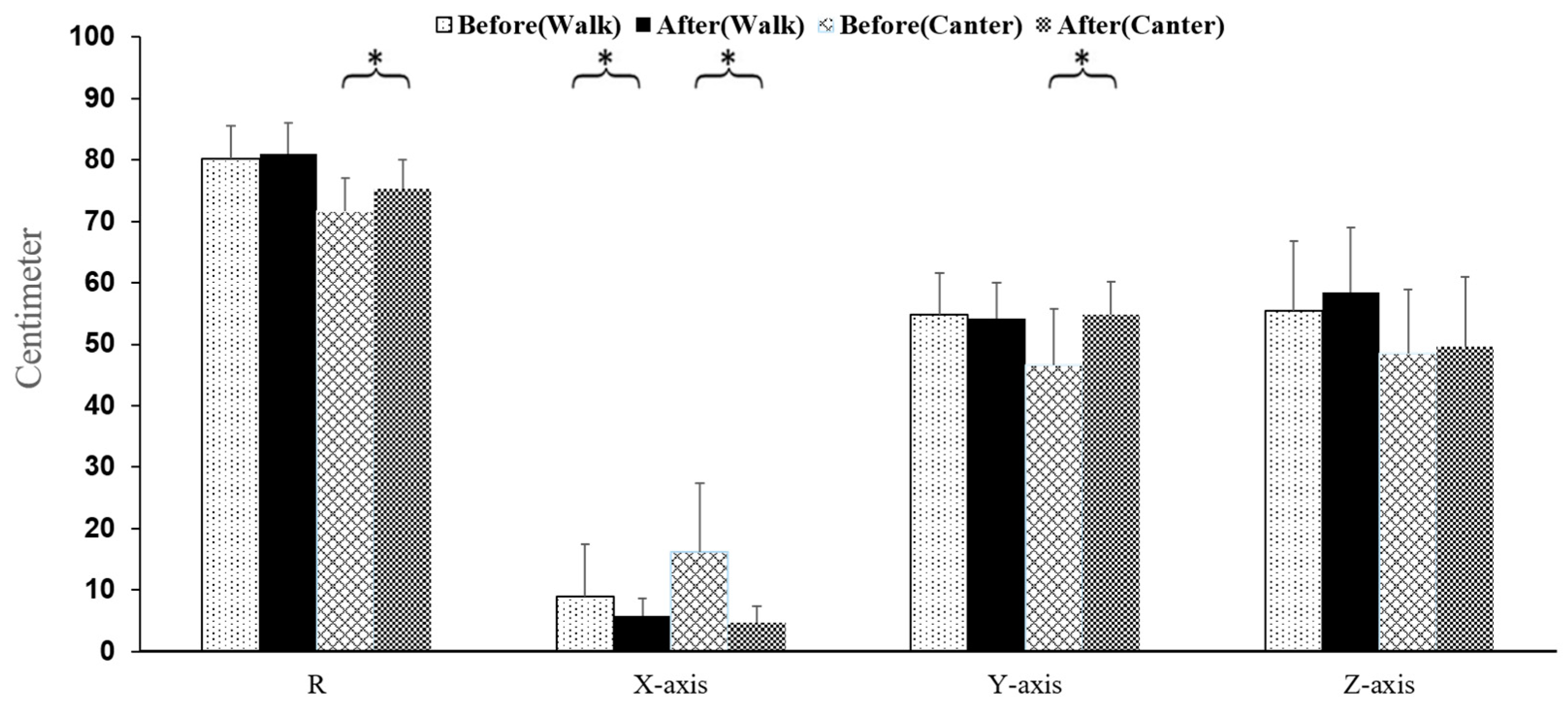The Effect of 12 Weeks of Saddle Horse Conversion Training on Thoroughbred Horse Gait
Abstract
:1. Introduction
2. Methods
2.1. Subjects
2.2. The Saddle Horse Conversion Training
2.3. Instrumentation
2.4. Experimental Procedure
2.5. Data Reduction and Analysis
3. Results
3.1. The Stride Lengths
3.2. Displacements of the Center of Mass and Center of the Head
3.3. The Center of Mass and the Center of Head Velocities
3.4. Head–Neck Angles
3.5. The Displacement between the Center of the Head and the Center of the Neck
4. Discussion
5. Conclusions
- The change in the stride length of each foot differed according to the gait. There was no significant difference in the stride lengths of the foot in Walk and Canter, though it decreased in all events;
- The saddle horse conversion training improved straightness of the body. There were no significant differences in the velocity of the center of the body and center of the head in Walk and Canter. Nonetheless, it was found that the movement of the center of the body and the center of the head decreased along the x-axis (left and right movement);
- The horses tried to focus their center on the rider. There was a significant decrease in head–neck angle in Walk. In addition, the displacement between the center of the head and the center of the neck was decreased in Canter.
- Although all Thoroughbreds were retired within six months from the start of the first gait analysis, the racehorse’s retirement time differed, so the gait test was not performed immediately after retirement;
- The prepost test in this study alone cannot reveal the causal relationship. It may be due to the absence of a control group, whose training level cannot be estimated because there is no information on the standard of excellent saddle horse and changes in gait due to injury or disease;
- There is a change in the environment in which the horse resides. Horses have been reported to be stressed depending on the environment in which they live. As an example, compared to traditional stable and natural horse boarding, horses living in a stable developed increased stress [32]. Since stress can have a negative effect on horse performance [33], the environmental conditions between the pre and posttests should be similarly configured.
Author Contributions
Funding
Institutional Review Board Statement
Informed Consent Statement
Data Availability Statement
Conflicts of Interest
References
- Bower, M.A.; McGivney, B.A.; Campana, M.; Gu, J.; Andersson, L.S.; Barrett, E.; Davis, C.R.; Mikko, S.; Stock, F.; Voronkova, V.; et al. The genetic origin and history of speed in the Thoroughbred racehorse. Nat. Commun. 2012, 3, 643. [Google Scholar] [CrossRef] [PubMed]
- American Horse Council Foundation. 2017 Economic Impact of the U.S. Horse Industry; American Horse Council Foundation: Washington, DC, USA, 2018. [Google Scholar]
- Khummuang, S.; Lee, H.G.; Joo, S.S.; Park, J.-W.; Choi, J.-Y.; Oh, J.H.; Kim, K.H.; Youn, H.-H.; Kim, M.; Cho, B.-W. Comparison for immunophysiological responses of Jeju and Thoroughbred horses after exercise. Asian-Australas. J. Anim. Sci. 2020, 33, 424–435. [Google Scholar] [CrossRef] [PubMed]
- Reed, S.K.; Ley, B.B.V.; Bell, R.P.; Wilson, D.A.; Wilborn, E.; Keegan, K.G. Survey on Thoroughbred use, health and owner satisfaction following retirement from racing. Equine Veter. Educ. 2019, 32, 82–87. [Google Scholar] [CrossRef]
- Crawford, K.L.; Finnane, A.; Greer, R.M.; Phillips, C.J.C.; Woldeyohannes, S.M.; Perkins, N.R.; Ahern, B.J. Appraising the Welfare of Thoroughbred Racehorses in Training in Queensland, Australia: The Incidence, Risk Factors and Outcomes for Horses after Retirement from Racing. Animals 2021, 11, 142. [Google Scholar] [CrossRef]
- Yeo, H. Retired Racing Horse Management System; A Publication of the Korea Racing Authority; Horse Industry Research Symposium: Gwacheon, Korea, 2019. [Google Scholar]
- Lee, K. Common Sense And Laws Related To Horses; Korea Disabled Writers Welfare Support Association: Seoul, Korea, 2020. [Google Scholar]
- Jung, T.-W.; Kim, T.-S. The influences of 12 weeks riding horse training program on Ear Position, Cortisol and Stress Index with Thoroughbred retired racehorse. Korean J. Sports Sci. 2020, 29, 931–939. [Google Scholar] [CrossRef]
- Valberg, S.J. Muscle anatomy, physiology, and adaptations to exercise and training. In The Athletic Horse: Principles and Practice of Equine Sports Medicine, 2nd ed.; Elsevier Inc.: Amsterdam, The Netherlands, 2013; pp. 174–201. [Google Scholar]
- Rivero, J.L.L.; Ruz, M.C.; Serrano, A.L.; Diz, A.M. Effects of a 3 month endurance training programme on skeletal muscle histochemistry in Andalusian, Arabian and Anglo-Arabian horses. Equine Veter. J. 1995, 27, 51–59. [Google Scholar] [CrossRef] [PubMed]
- Cano, M.; Miró, F.; Diz, A.; Agüera, E.; Galisteo, A. Influence of training on the biokinematics in trotting Andalusian horses. Veter. Res. Commun. 2000, 24, 477–489. [Google Scholar] [CrossRef]
- Corley, J.M.; Goodship, A.E. Treadmill training induced changes to some kinematic variables measured at the canter in Thoroughbred fillies. Equine Veter. J. 2010, 26, 20–24. [Google Scholar] [CrossRef]
- van Weeren, P.; Bogert, A.V.D.; Back, W.; Bruin, G.; Barneveld, A. Kinematics of the Standardbred Trotter Measured at 6, 7, 8 and 9 m/s on a Treadmill, before and after 5 Months of Prerace Training. Cells Tissues Organs 1993, 146, 154–161. [Google Scholar] [CrossRef]
- Drevemo, S.; Dalin, G.; Fredricson, I.; Björne, K. Equine locomotion: 3. The reproducibility of gait in Standardbred trotters. Equine Veter. J. 1980, 12, 71–73. [Google Scholar] [CrossRef]
- Abdel-Aziz, Y.I.; Karara, H.M.; Hauck, M. Direct linear transformation from comparator coordinates into object space coordinates in close-range photogrammetry. Photogramm. Eng. Remote Sens. 2015, 81, 103–107. [Google Scholar] [CrossRef]
- Padalino, B.; Riley, C.B. The implications of transport practices for horse health and welfare. Front. Vet. Sci. 2020, 7, 202. [Google Scholar] [CrossRef] [PubMed] [Green Version]
- Stowe, C.J.; Kibler, M.L. Characteristics of Adopted Thoroughbred Racehorses in Second Careers. J. Appl. Anim. Welf. Sci. 2015, 19, 81–89. [Google Scholar] [CrossRef] [PubMed]
- Holcomb, K.E.; Stull, C.L.; Kass, P.H. Unwanted horses: The role of nonprofit equine rescue and sanctuary organizations1. J. Anim. Sci. 2010, 88, 4142–4150. [Google Scholar] [CrossRef] [PubMed]
- Cavanagh, P.R.; Williams, K.R. The effect of stride length variation on oxygen uptake during distance running. Med. Sci. Sports Exerc. 1982, 14, 30–35. [Google Scholar] [CrossRef]
- Hoyt, D.F.; Taylor, C.R. Gait and the energetics of locomotion in horses. Nature 1981, 292, 239–240. [Google Scholar] [CrossRef]
- Leach, D.H. Equine Exercise Physiology 2. In Locomotion Of The Athletic Horse; ICEEP Publications: Davis, CA, USA, 1987; pp. 516–535. [Google Scholar]
- van Oldruitenborgh Oosterbaan, M.S.; Barneveld, A.; Schamhardt, H.C. Kinematics of unmounted and mounted horses at walk before and after treadmill exercise. Pferdeheilkunde 1996, 12, 651–655. [Google Scholar] [CrossRef]
- Pearce, G.P.; May-Davis, S.; Greaves, D. Femoral asymmetry in the Thoroughbred racehorse. Aust. Vet. J. 2005, 83, 367–370. [Google Scholar] [CrossRef]
- Rhodin, M.; Pfau, T.; Roepstorff, L.; Egenvall, A. Effect of lungeing on head and pelvic movement asymmetry in horses with induced lameness. Vet. J. 2013, 198, e39–e45. [Google Scholar] [CrossRef] [Green Version]
- Pfau, T.; Noordwijk, K.; Sepulveda Caviedes, M.F.; Persson-Sjodin, E.; Barstow, A.; Forbes, B.; Rhodin, M. Head, withers and pelvic movement asymmetry and their relative timing in trot in racing Thoroughbreds in training. Equine Vet. J. 2018, 50, 117–124. [Google Scholar] [CrossRef]
- Kelmer, G.; Keegan, K.G.; Kramer, J.; Wilson, D.A.; Pai, F.P.; Singh, P. Computer-assisted kinematic evaluation of induced compensatory movements resembling lameness in horses trotting on a treadmill. Am. J. Vet. Res. 2005, 66, 646–655. [Google Scholar] [CrossRef] [PubMed]
- Rhodin, M.; Byström, A.; Roepstorff, L.; Hernlund, E.; Van Weeren, P.R.; Weishaupt, M.A.; Egenvall, A. Effect of different head and neck positions on kinematics of elite dressage horses ridden at walk on treadmill. Comp. Exerc. Physiol. 2018, 14, 69–78. [Google Scholar] [CrossRef]
- Rhodin, M.; Álvarez, C.B.G.; Byström, A.; Johnston, C.; Van Weeren, P.R.; Roepstorff, L.; Weishaupt, M.A. The effect of different head and neck positions on the caudal back and hindlimb kinematics in the elite dressage horse at trot. Equine Veter. J. 2009, 41, 274–279. [Google Scholar] [CrossRef]
- Janssen, S. Zur Brust genommen. Reit. Rev. 2003, 46, 41–45. [Google Scholar]
- Balkenhol, K.; Müller, H.; Plewa, M.; Heuschmann, G. Zur Entfaltung kommen–statt zur Brust genommen. Reit. Rev. 2003, 2, 46–51. [Google Scholar]
- Heuschmann, G. Tug of War: Classical Versus “Modern” Dressage: Why Classical Training Works and How Incorrect “Modern” Training Negatively Affects Horses’ Health; Trafalgar Square Books: Pomfret, VT, USA, 2007. [Google Scholar]
- Placci, M.; Marliani, G.; Sabioni, S.; Gabai, G.; Mondo, E.; Borghetti, P.; De Angelis, E.; Accorsi, P.A. Natural Horse Boarding Vs. Traditional Stable: A Comparison of Hormonal, Hematological and Immunological Parameters. J. Appl. Anim. Welf. Sci. 2019, 23, 366–377. [Google Scholar] [CrossRef]
- Bartolomé, E.; Cockram, M.S. Potential Effects of Stress on the Performance of Sport Horses. J. Equine Vet. Sci. 2016, 40, 84–93. [Google Scholar] [CrossRef]





| Week | Purpose | Training Content |
|---|---|---|
| 1st | Environmental adaptation and bonding with trainer | Resting and lunge, grooming |
| 2nd | Understanding of aids | Riding with lunging |
| 3rd | Making straightness tread and (neck) Flexion | Riding without lunging, transition |
| 4th | Increasing balance and flexibility with using cavaletti | Lunging with side-rein |
| 5th | Maintain rhythm for transitioning | Transition and aids (Walk, Trot, Canter, Half-Halt) |
| 6th | Retain composure | Jumping over the ground poles |
| 7th | Desensitization | Flag, tent, spray, and noise Jumping under 60 cm |
| 8th | Basic dressage | Changing stride (collection and extension) Counter Canter, Simple Change, Work on two tracks, etc. |
| 9th | Show jumping | Jumping under 80 cm |
| 10th | Schooling with desensitization | Stimulation for riding Figure 8 motion, serpentine, etc. Half-Pass, leg yielding, etc. |
| 11th and 12th | Review | Review |
| Walk (Before) | Walk (After) | t | p | Canter (Before) | Canter (After) | t | p | ||
|---|---|---|---|---|---|---|---|---|---|
| Center of mass | x | 33.10 ± 20.40 | 23.20 ± 14.91 | 2.546 | 0.016 * | 22.13 ± 12.82 | 11.73 ± 4.96 | 2.559 | 0.023 * |
| y | 492.03 ± 77.07 | 496.40 ± 97.54 | −0.158 | 0.875 | 524.93 ± 75.54 | 522.67 ± 82.89 | 0.077 | 0.940 | |
| z | 115.90 ± 3.63 | 116.57 ± 4.28 | −1.646 | 0.110 | 114.53 ± 2.59 | 114.07 ± 3.24 | 0.640 | 0.533 | |
| Center of head | x | 31.67 ± 14.49 | 26.45 ± 15.85 | 2.106 | 0.043 * | 22.88 ± 19.09 | 12.06 ± 8.42 | 2.812 | 0.013* |
| y | 532.73 ± 78.32 | 539.73 ± 98.19 | −0.296 | 0.769 | 601.35 ± 45.61 | 593.06 ± 32.90 | 0.350 | 0.731 | |
| z | 162.06 ± 11.85 | 165.55 ± 10.74 | −1.612 | 0.117 | 155.18 ± 16.80 | 155.29 ± 12.53 | −0.035 | 0.972 | |
| Walk (Before) | Walk (After) | t | p | Canter (Before) | Canter (After) | t | p | |
|---|---|---|---|---|---|---|---|---|
| Center of mass | 1.58 ± 0.26 | 1.57 ± 0.31 | 0.079 | 0.938 | 4.20 ± 0.56 | 4.09 ± 0.67 | 0.474 | 0.643 |
| Center of head | 1.73 ± 0.28 | 1.71 ± 0.30 | 0.167 | 0.868 | 4.83 ± 2.49 | 4.63 ± 1.23 | 1.038 | 0.315 |
| Walk (Before) | Walk (After) | t | p | Canter (Before) | Canter (After) | t | p | |
|---|---|---|---|---|---|---|---|---|
| E1 | 75.54 ± 7.98 | 71.54 ± 9.54 | 2.272 | 0.030 * | 66.65 ± 10.19 | 63.43 ± 8.73 | 1.534 | 0.146 |
| E2 | 79.38 ± 7.47 | 75.21 ± 9.23 | 2.534 | 0.016 * | 66.12 ± 10.26 | 61.98 ± 9.66 | 2.176 | 0.043 * |
| E3 | 75.90 ± 8.70 | 72.41 ± 8.68 | 2.226 | 0.033 * | 66.13 ± 10.06 | 61.60 ± 10.34 | 2.317 | 0.033 * |
| E4 | 78.32 ± 7.61 | 74.67 ± 7.97 | 2.277 | 0.030 * | 68.73 ± 10.83 | 63.56 ± 11.38 | 1.967 | 0.066 |
| E5 | 74.87 ± 8.82 | 70.63 ± 9.99 | 2.352 | 0.025 * | 72.84 ± 11.99 | 63.38 ± 9.27 | 2.660 | 0.022 * |
| E6 | 78.91 ± 7.88 | 74.88 ± 9.41 | 2.098 | 0.044 * | 73.12 ± 13.28 | 60.90 ± 6.28 | 2.790 | 0.032 * |
| E7 | 74.93 ± 7.04 | 70.85 ± 10.54 | 2.182 | 0.037 * | 72.32 ± 13.68 | 61.95 ± 6.40 | 2.088 | 0.091 |
| E8 | 78.10 ± 6.62 | 74.72 ± 8.11 | 2.385 | 0.023 * | 71.64 ± 10.90 | 66.23 ± 6.89 | 1.414 | 0.217 |
| Average | 76.98 ± 6.67 | 73.11 ± 8.27 | 2.688 | 0.011 * | 68.65 ± 10.34 | 63.89 ± 9.94 | 2.072 | 0.053 |
Publisher’s Note: MDPI stays neutral with regard to jurisdictional claims in published maps and institutional affiliations. |
© 2022 by the authors. Licensee MDPI, Basel, Switzerland. This article is an open access article distributed under the terms and conditions of the Creative Commons Attribution (CC BY) license (https://creativecommons.org/licenses/by/4.0/).
Share and Cite
Jung, T.; Park, H. The Effect of 12 Weeks of Saddle Horse Conversion Training on Thoroughbred Horse Gait. Appl. Sci. 2022, 12, 6411. https://doi.org/10.3390/app12136411
Jung T, Park H. The Effect of 12 Weeks of Saddle Horse Conversion Training on Thoroughbred Horse Gait. Applied Sciences. 2022; 12(13):6411. https://doi.org/10.3390/app12136411
Chicago/Turabian StyleJung, Taewoon, and Hyoungjin Park. 2022. "The Effect of 12 Weeks of Saddle Horse Conversion Training on Thoroughbred Horse Gait" Applied Sciences 12, no. 13: 6411. https://doi.org/10.3390/app12136411
APA StyleJung, T., & Park, H. (2022). The Effect of 12 Weeks of Saddle Horse Conversion Training on Thoroughbred Horse Gait. Applied Sciences, 12(13), 6411. https://doi.org/10.3390/app12136411





